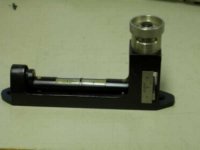At RARDE we frequently made special purpose lab and demonstrator equipment incorporating sensitive levels. Normal practice was to seat the vial in a recessed carrier with a fibre sheet material protecting the vial from direct contact with the metal parts and, probably, giving a measure of insulation. Working to military temperature ranges a bit of compliance to cope with differences in thermal expansion between materials was pretty much essential. As I recall matters it looked like blotting paper, heck it might even have been blotting paper for all I know being very much on the user, not designer, end for that. Adjustment would be either by shims or some form of mount rotation. The one device still in my possession (an optical clinometer demonstrator issued as part of a post redundancy consultancy contract) effectively has a rotatable carrier.
I do wonder whether a DIY master precision level is the right way of going about things if you are mostly interested in having a tool to help machine tool refurbishment. I always preferred a clinometer style device with a short, accurately calibrated tilt scale for optics lab work and machine alignment. My favourite has a 6" base, 20 second vial and 10 degrees of tilt one way graduated down to 10 seconds of arc. Compact, easy to handle and you can do rough alignment with the adjuster. The master precision level came out of its box, I think, once in 20 odd years to confirm it was too much of a PIA to use. Naturally if you want the pride of (very considerable) accomplishment in making a master precision level its a different matter.
Clive




